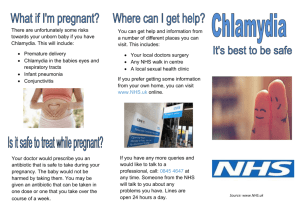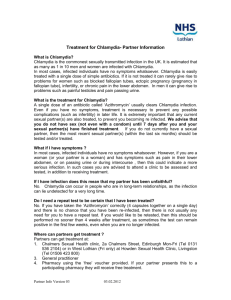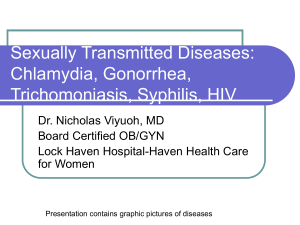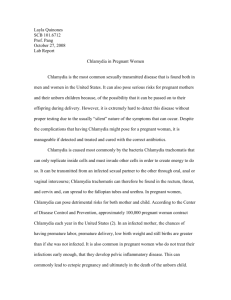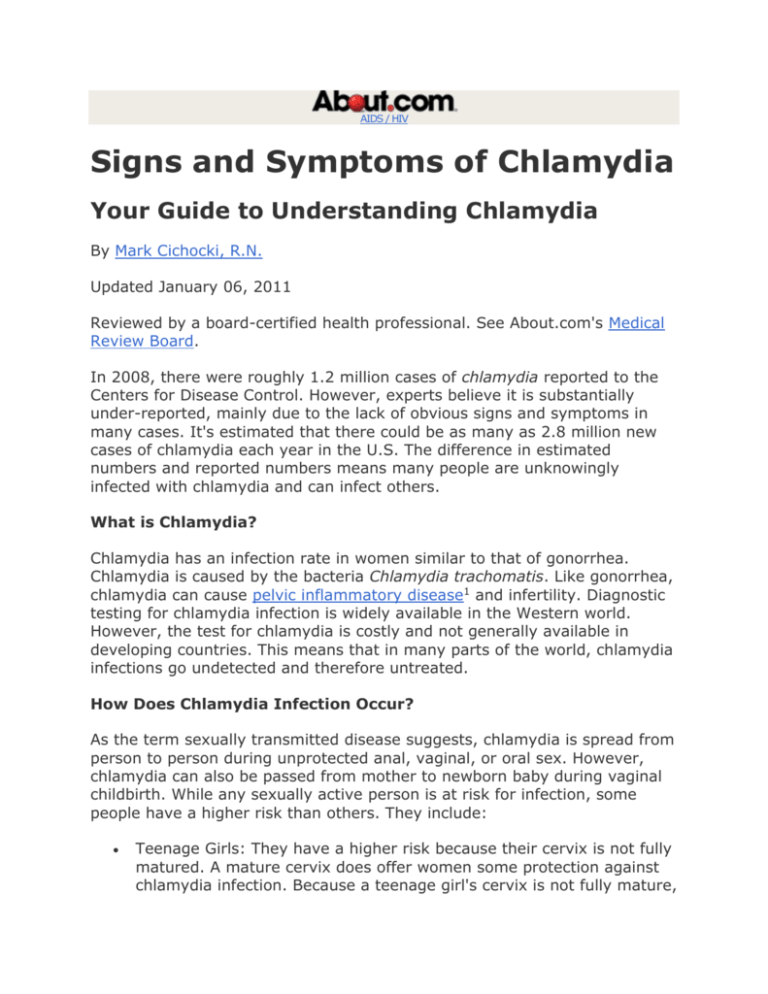
AIDS / HIV
Signs and Symptoms of Chlamydia
Your Guide to Understanding Chlamydia
By Mark Cichocki, R.N.
Updated January 06, 2011
Reviewed by a board-certified health professional. See About.com's Medical
Review Board.
In 2008, there were roughly 1.2 million cases of chlamydia reported to the
Centers for Disease Control. However, experts believe it is substantially
under-reported, mainly due to the lack of obvious signs and symptoms in
many cases. It's estimated that there could be as many as 2.8 million new
cases of chlamydia each year in the U.S. The difference in estimated
numbers and reported numbers means many people are unknowingly
infected with chlamydia and can infect others.
What is Chlamydia?
Chlamydia has an infection rate in women similar to that of gonorrhea.
Chlamydia is caused by the bacteria Chlamydia trachomatis. Like gonorrhea,
chlamydia can cause pelvic inflammatory disease1 and infertility. Diagnostic
testing for chlamydia infection is widely available in the Western world.
However, the test for chlamydia is costly and not generally available in
developing countries. This means that in many parts of the world, chlamydia
infections go undetected and therefore untreated.
How Does Chlamydia Infection Occur?
As the term sexually transmitted disease suggests, chlamydia is spread from
person to person during unprotected anal, vaginal, or oral sex. However,
chlamydia can also be passed from mother to newborn baby during vaginal
childbirth. While any sexually active person is at risk for infection, some
people have a higher risk than others. They include:
Teenage Girls: They have a higher risk because their cervix is not fully
matured. A mature cervix does offer women some protection against
chlamydia infection. Because a teenage girl's cervix is not fully mature,
her risk of chlamydia is higher. It is important to note that even in
women old enough to have a mature cervix, chlamydia infection can
and does occur.
Men Who Have Sex with Men: Because chlamydia spreads during oral
and anal sex in addition to vaginal sex, men who have sex with men2
are also at risk for chlamydia infection.
What Are the Signs and Symptoms of Chlamydia?
About 75 percent of women and 50 percent of men who have chlamydia
have no symptoms. But if symptoms do appear, they do so about one to
three weeks after infection. These symptoms vary between men and women.
Symptoms in Women3
vaginal discharge
burning or pain with urination
abdominal and/or low back pain4
nausea5
fever6
pain with intercourse
vaginal bleeding between periods
Symptoms in Men
burning or pain with urination
penile discharge
burning and itching at the tip of the penis7
swollen and painful testes
Important Fact!
If left untreated, chlamydia can cause permanent damage to the
reproductive system in both males and females. However, the damage
caused by chlamydia may go unnoticed because many times there are no
symptoms. For this reason, treatment of chlamydia is necessary despite the
appearance or absence of symptoms.
How is Chlamydia Treated?
Fortunately, treatment of chlamydia is easy and effective. A variety of
antibiotics8 taken for various lengths of time will successfully treat a
chlamydia infection. These antibiotics include:
Azithromycin9 (Zithromax) - one day course
Doxycycline - seven day course
Erythromycin
Amoxicillin
Keep in mind that that all doses of the antibiotic must be taken even if the
person is feeling better or is symptom-free. Also, sexual activity must be
avoided during treatment and all sexual partners of an infected person must
be tested and treated.
Important Information!
Women and teenage girls should be re-tested a few months after treatment.
Because of the risk of reinfection from an untreated partner and the
potential harm chlamydia can do to the reproductive system, it is important
to make sure the chlamydia has been treated completely and that reinfection has not occurred.
Source:
Atlanta,
GA: U.S. Department of Health and Human Services, November 2009.
Centers for Disease Control and Prevention. "Sexually Transmitted Disease Surveillance, 2008"
11
National Institute of Allergy and Infections Diseases; "Chlamydia Fact Sheet" ;
Health; 10 Nov 2010.
10;
National Institutes of
This About.com page has been optimized for print. To view this page in its
original form, please visit: http://aids.about.com/od/stds/a/Chlamydia-AndHiv.htm
©2013 About.com, Inc. All rights reserved.
Links in this article:
1. http://adam.about.net/encyclopedia/infectiousdiseases/Pelvicinflammatory-disease-PID.htm
2. http://aids.about.com/od/howtostayhealthy/tp/gayten.htm
3. http://adam.about.net/encyclopedia/infectiousdiseases/Chlamydiainfections-in-women.htm
4. http://adam.about.net/encyclopedia/Low-back-pain-acute.htm
5. http://aids.about.com/cs/conditions/qt/Nausea.htm
6. http://aids.about.com/cs/conditions/qt/fever.htm
7. http://adam.about.net/encyclopedia/infectiousdiseases/Chlamydialurethritis-male.htm
8. http://aids.about.com/od/drugfactsheets/qt/abindex.htm
9. http://aids.about.com/cs/druginformation/p/zithromax.htm
10.
http://www.cdc.gov/std/stats09/chlamydia.htm
11.
http://www.niaid.nih.gov/topics/chlamydia/pages/default.aspx

